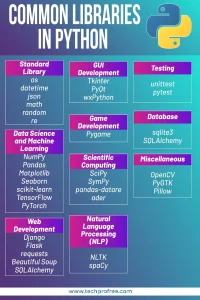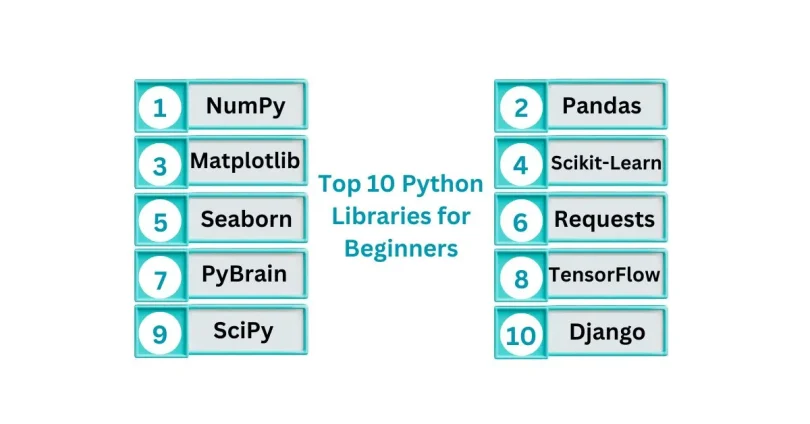One of the most imposing aspects of the Python Programming language to newcomers is the number of available libraries. These libraries act like plug-and-play kits in a way that developers can use pre-coded functions to increase their project production. This article provides an overview of the top ten Python libraries that are suitable for newbies or beginners. Regardless of whether you are developing a small project or are just starting with the basics of working with Python, these libraries can be very useful or helpful.
The presence of countless features has made Python a versatile language due to its simple syntax which is suitable/appropriate for beginners. One of the significant strengths is the availability and vast number of open-source libraries for use in Python. In general, a Python library is a cluster of related modules that can be introduced into a program or project and it can spare developers from writing code.
Some modules/libraries are installed by default with Python while others are installed separately though they are standard libraries. These libraries can once installed be imported into a project to enable one to access nearly all the functions.
What is a Python Library?
It consists of collections of modules and packages that offer various functions. These libraries allow developers to carry out multiple tasks without the need to create the code from scratch. It is pre-coded and stored components most of which are known as codes classes functions or routines that have been widely used in application development, and or while performing a task such as data manipulation mathematical calculations, etc.
How Python Libraries Work?
A Python library is simply a collection of standard codes or packages developed to solve certain purposes. These libraries just give you solutions required to write a lot of code from scratch which may be time-consuming. For example in the Microsoft Window environment library files are typically referred to as files that have the .DLL or Dynamic Link Library extension. When a program calls such a library and is run, a developer will find the library, pull the functions out of it and insert them into the program.
The extensive Python library ecosystem covers multiple domains, including:
- Web Development: Frameworks such as Django and Flask
- Data Analysis: Frameworks such as the pandas and NumPy libraries
- Machine Learning: Examples of libraries are TensorFlow and scikit-learn.
- Image Processing
- Scientific Computing: Libraries like SciPy
Uses of Python Libraries
Importing Libraries
- The import statement is used to bring libraries into a program.
- Transfer a whole package or particular sections of it into their program, according to the projects.
Functions and Classes
- Activate certain functions, classes, and other objects defined in the library before using them.
- Use these elements in your project where necessary to ease your work/comfort.
Reading Documentation
- One should also learn to use a library’s documentation, including its functionalities, parameters, return values, and even examples.
Managing Dependencies
- Copy shown libraries and their dependencies and install them using tools like pip.
Optimizing Performance
- Python libraries usually have the best code written in the most efficient manner.
- The use of these libraries can be highly beneficial in accomplishing complex tasks in considerably less time.
Customizing Functionality
- Some libraries offer ways of customization or extension.
- Subclassing other classes in the library, extending modification or redefining methods, or changing the settings as desired or required is possible.
Python libraries are useful implements for beginner and professional coders throughout their work. They enable users to achieve a variety of goals effectively and create a basis for further programming. Through this guide, the newcomers will be able to utilize all the opportunities that the powerful Python language offers with the help of its libraries.
Beginner-Friendly Python Libraries
Python as an easy-to-use and flexible language has gained great popularity among programmers. One of the reasons for its success is the large number of available libraries, thanks to which developers can solve difficult issues promptly.
- NumPy
- Pandas
- Matplotlib
- Scikit-Learn
- Seaborn
- Requests
- PyBrain
- TensorFlow
- SciPy
- Django

In this section, 10 Python libraries that can be useful for beginners who want to enhance their programming skills and create efficient applications are presented/overviewed or discussed.
1. NumPy
Primary Purpose: Numerical computation
Although there are many libraries in Python, NumPy is undoubtedly the most fundamental library for computations and data analysis. Its chief characteristic is the multi-dimensional array, a complex type of data; that allows working with complex datasets and properly performing mathematical procedures associated with arrays without complicated calculations. The main activities such as slicing of arrays, and reshaping as well as the element-wise operations are supported by NumPy. Besides, the capability of performing complex linear algebra operations, Fourier transforms, and statistical functions makes it a scientific computation base. Users can use NumPy to improve computational speed and make their analytical processes much more efficient.
The library also adds new operations including broadcasting which allows for operations on arrays of distinct shapes as a way of eliminating iteration. It enhances compatibility with other well-known Python libraries due to Python support for constructing practical graphics, Matplotlib. If you are looking for help, you will always be able to find it since a large number of developers have used this library for different applications from scientific simulations, signal processing, machine learning, and data analysis.
Features that include matrix math, statistical computations and other complex mathematical computations along with efficient array operations.
Why it is beginner-friendly?
- Simple data access and modification language
- Perfect for students and new coding users solving numerical issues and data analysis.
2. Pandas
Primary Purpose: Manipulation and management of data
Pandas is a well-known library intended for handling and analyzing structured data. One of its key components is the DataFrame: it is a data structure that has a tabular appearance like spreadsheets of SQL tables while being a highly customizable data representation.
This means that with pandas, users can easily import, clean and manipulate data from many formats such as CSV, Excel, and SQL. It provides all the requirements of data preparation and cleaning such as selection, transformation, joining, and aggregating data. Pandas has an easy and flexible method of data manipulation and therefore complex data operations can be done efficiently.
It also features very strong indexing and slicing in that it can select subsets of data based on various conditions much more easily than can be done with other languages. It also offers less sensitive techniques for handling missing data such as imputing or even dropping null values. The capability of the library for time series data extends its utility even further, making it essential for time series data. It is now a standard part of the Python data science stack, being easily integrated with libraries such as NumPy and Matplotlib. However, it is used in data analysis workflow, exploratory data analysis, data cleaning and feature creation as a reliable solution for different data-related issues.
Features
- Flexible structure of DataFrame for tabular data.
- Techniques to filter the data, group the data and how handle missing values.
- Reduces management of structured data sets
- Allows easy working with frequently used file formats such as CSV and Excel.
3. Matplotlib
Primary Purpose: Data visualization
Data presentation is a very important aspect of data analysis and reporting. The plotting library called Matplotlib provides a wide range of features to generate various and beautiful graphical representations including line plots, scatter plots, bar plots, histograms, heatmaps, etc. It has powerful features that can fully allow users to specify features such as axes, labels, colors, and styles to obtain professional quality outputs.
Its seamless integration with NumPy makes it particularly well-suited for visualizing data stored in arrays and matrices. This capability helps in the investigation of patterns, sharing of results and developing of a powerful visual story. In addition, the library commits to generating various formats of output such as still images, dynamic plots, and animations. This tool is very useful or helpful both for data analysis and presentation.
Key Features
- Various plot types such as line, scatter, bar and pie chart
- The visualizations are fully customizable with choices for labels, titles, and legends
- Makes it easier to convert quantitative data into easy-to-understand visuals
- Simple language to enable users to gain the best results in minimum time.
4. Scikit-Learn
Scikit-Learn is a popular open-source machine learning library for Python, widely utilized by developers and data scientists. It is developed for supervised and unsupervised learning and includes tools for linear regression, classification, clustering, etc.
Designed to integrate with NumPy and SciPy, Scikit-Learn is must-have library when dealing with data processing tasks.
This library provides complete solutions for the machine learning pipeline right from data loading, data cleaning, data preparation, feature engineering, model training and model evaluation. It is very flexible and can be used on projects that deal with numerical data, text or even images. It also has in-built datasets that help learners practice on concepts of machine learning without having to look for datasets on their own.
Key Features
- It supports classification, regression and clustering model tasks.
- Feature scaling and data splitting are the preprocessing tools that are usually used.
- A vast amount of tutorials and very organized documentation.
- Machine learning made easy through an easily understandable API
5. Seaborn
Primary Purpose: Statistical data visualization
Seaborn is a Python visualization library built on top of Matplotlib, offering a simplified interface for creating visually appealing and insightful statistical plots. This allows users to create informative and attractive graphics in a simple and visually appealing way. It is especially useful in visualizing statistical models like heat maps. Also works perfectly with the most used data structures in pandas.
It has integrated themes for making plots more appealing and useful plotting functions for categorical data, multiple plots in a grid and many more. Seaborn’s focus on simplifying complex visualizations makes it an excellent choice for users who want to create insightful statistical graphics with minimal effort.
Key Features
- High level interface for complex plots
- Prescribed topics for neat and tidy appearance
- Pandas integration is very good for enhanced data analysis.
Beginner-friendly because…
- Reduces the workload of designing complex plots.
- Simplified procedures for creating statistical graphics with little or no training needed
6. Requests
Main Purpose: HTTP requests handling
It is an HTTP client library for Python that is easy to use and has a lot of features. It is one of the most famous Python libraries with more than 300 million monthly downloads, which allows developers to work with web services and APIs.
Originally developed as a wrapper for urllib3, Requests is designed to overlay the HTTP protocol on Python’s object-oriented model, making it as simple to use as possible.
With Requests, one can make HTTP/1.1 requests with methods like GET, POST, PUT, and DELETE. It also supports other aspects such as headers, form, file multipart, and query parameters. This has made it to be among the easiest HTTP client libraries that have been developed in other programming languages.
Key Features
- Support for GET, POST, PUT and DELETE HTTP methods.
- Easy to administer headers, parameters and multipart data.
- Integrated error control features
- Clear and concise syntax.
- Perfect for learning web scraping and API integration.
7. PyBrain
As a simple and flexible tool, it has fast and easy-to-use algorithms for the different ML applications such as neural networks and reinforcement learning.
In its implementation, it is based on Python, which makes development much faster than in languages such as Java or C++. Compatible with a number of common network types such as feed-forward, recurrent and neural networks and is also well-matched with other Python libraries for tasks such as data visualization.
Advantages of PyBrain
- Free and open source with easy-to-follow instructions which are suitable for a novice.
- Easy to interface with other Python libraries
- Supports handling datasets in .csv format and importing datasets from external libraries
- Reduces training and testing time since trainers are dedicated.
Challenges
- Fewer community resources for help in solving problems.
8. PyGame
Major Purpose: Computer games and multimedia programs.
It is a set of modules of Python that is developed to make the game development process easier. Setting the integration on SDL, PyGame offers tools for developing fully-routinary 2D games and other multimedia applications.
It has many features and supports graphics and animations, audio and events handling that’s why PyGame is a base for side-scrollers, arcady, and puzzle game developers. It is a well-known framework for building game applications, recognized for its vibrant community and comprehensive resources.
Key Features
- Cross-compatibility of the layer for porting game applications across different platforms
- Perfect for developing simple 2D games that incorporate powerful animation features.
- Improved event handling for controlling keyboard, mouse, and other input devices.
- High community engagement and numerous learning materials
- Free and easy to use
- Good for learning game mechanics and the use of the application for interactive purposes
9. PyTorch
PyTorch is undoubtedly or arguably one of the best machine learning libraries for tensor computation built with easy-to-use APIs and supporting GPU acceleration. While being a powerful and productive deep learning framework it is widely adopted for building models in various domains, including image and text analysis. Developed in Python and built on Torch, PyTorch operates on the dynamic computation graph that gives operational versatility by enabling runtime evaluation and debugging of components of the neural network.
This Pythonic library is loved by developers and researchers due to its simplicity and the possibility to manage both CPU and GPU computations.
Features of PyTorch
- Tensor Computation: It is like NumPy but with better support for operations on GPU.
- Automatic Differentiation: It helps in simplification of deep neural networks if one can create and train.
Why PyTorch is preferred?
- Dynamic computation graphs for real-time testing.
- Pythonic design, which means it will be easy to use and easy to understand for beginners
- Clear stakeholder support together with well-recorded evidence.
10. Keras
It is a neural network library that is implemented with a high level of abstraction. It minimizes the user’s actions for typical programming operations, which makes it appropriate or a good choice for developers and researchers.
However, due to the looming complexity, it carries simple, clear, and actionable error messages that enhance productivity by minimizing debugging time. It is easy to use and allows for easy testing and the library is easily compatible with backend frameworks such as TensorFlow.
The research organizations such as CERN, NASA, and NIH use Keras for their complex computation.
Features of Keras
- Simplified design for human-oriented programming
- Effective messages to increase work efficiency.
- Perfect for creating a proof of concept and testing.
Notable use cases…
- Science and experimentation.
- Advanced learning tasks in academia and industry.
Summary
Python libraries are helpful for novices or beginners as they provide definite/confident guidelines for approaching different problems with the help of the programming language. As a result, learners can optimize their work with the help of basic libraries such as NumPy, Pandas, Matplotlib, and others mentioned in this article and have a strong base for further projects. The availability of these libraries and their versatility make Python a favorite language for new learners and experts in computer sciences. Carrying on your voyage, these libraries will help you to open the door to solutions and opportunities in programming.
FAQs
Python library is one of the collections of pre-written code, functions, and modules that exist primarily to assist the programmer. It is beneficial as it provides an easy and quick way of implementing functions that have to be used by developers in the application.
Absolutely yes. Python allows using multiple libraries in a project, and you can integrate elements of different libraries in the action.
Almost every library has official documentation available on the library’s website or on GitHub. These resources include step-by-step guides, examples, and recommended procedures.
In Crystal, a module is a single file including only Python code and a library is a set of several modules that are devoted to the same purpose.
Some examples include NumPy, Pandas and Matplotlib, NumPy is an ideal library to learn from because it tackles basic segments such as numerical computing.




Leave a Comment